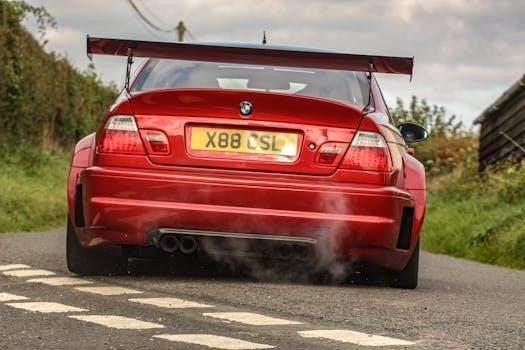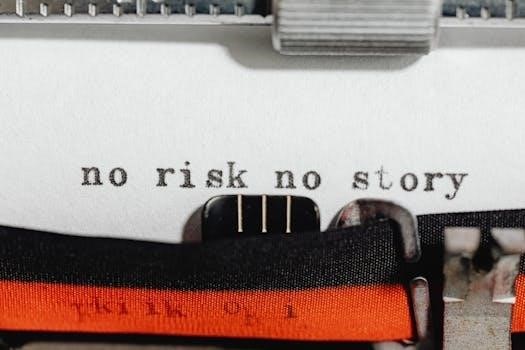E46 M3 Manual Swap⁚ A Comprehensive Guide
The BMW E46 M3‚ celebrated for its high-revving engine and engaging driving dynamics‚ originally offered both a manual and an SMG transmission․ This guide offers a complete overview of converting an SMG-equipped E46 M3 to a traditional manual gearbox‚ and improving the overall driving experience․
The E46 M3‚ produced from 2000 to 2006‚ stands as an icon of BMW’s engineering prowess․ Renowned for its naturally aspirated inline-six engine‚ near-perfect balance‚ and engaging driving experience‚ the E46 M3 quickly became a benchmark for sports coupes․ While a traditional manual transmission was available‚ BMW also offered the SMG‚ or Sequential Manual Gearbox‚ as an option․
The SMG was a revolutionary system at the time‚ offering clutchless gear changes via paddles or the gear lever․ Although it provided faster shifts than a conventional manual in certain situations‚ it wasn’t without its drawbacks․ The SMG system on the E46 M3 was known for its jerky operation at low speeds‚ high maintenance costs‚ and potential reliability issues‚ like hydraulic pump failures․
As the SMG units aged‚ many owners began to explore alternative solutions‚ with the manual conversion being the most popular․ Converting from SMG to manual allows enthusiasts to restore the original driving feel intended by BMW and improve the car’s reliability․
Why Consider a Manual Swap?
Several compelling reasons motivate E46 M3 owners to consider a manual swap․ The SMG transmission‚ while innovative for its time‚ suffers from common issues‚ including hydraulic pump failures and slow‚ jerky shifts‚ especially at lower speeds․ Repairing or replacing the SMG system can be expensive‚ making the manual swap a cost-effective long-term solution for some owners․
A manual swap is often undertaken to improve the driving experience․ Many enthusiasts prefer the greater control‚ engagement‚ and feedback offered by a traditional manual gearbox․ The manual transmission provides a more direct connection to the engine‚ enhancing the overall feel of the car․
Another reason is reliability․ The SMG system is more complex than a manual‚ with more components that can fail․ Converting to a manual simplifies the drivetrain‚ reducing the risk of breakdowns and associated repair costs․ Converting to a manual can also increase the resale value of the car․
Benefits of Converting to Manual
Converting your E46 M3 from SMG to manual offers a multitude of benefits․ Firstly‚ it significantly enhances the driving experience․ The manual transmission provides a more direct connection to the engine‚ giving the driver greater control and a more engaging feel․ Shifts are more precise and responsive‚ offering a more rewarding driving experience․
Improved reliability is another key advantage․ The SMG system is known for its complexity and potential for failure‚ leading to costly repairs․ A manual transmission is simpler and more robust‚ reducing the risk of breakdowns and associated expenses․ This conversion can also enhance the car’s resale value‚ as manual M3s are highly sought after by enthusiasts․
Finally‚ a manual swap allows for a more personalized driving experience․ The ability to select gears manually offers a greater sense of control and connection to the car‚ making it a more enjoyable and rewarding experience overall․

Common Issues with the SMG Transmission
The SMG (Sequential Manual Gearbox) transmission in the E46 M3‚ while innovative for its time‚ is prone to several issues․ One common problem is hydraulic pump failure․ The SMG system relies on a hydraulic pump to actuate gear changes‚ and these pumps can wear out or fail over time‚ leading to shifting problems or complete transmission failure․
Another frequent issue is with the SMG control unit (ECU)․ This unit manages the shifting process‚ and malfunctions can cause erratic shifting‚ error codes‚ and even immobilization of the vehicle․ Furthermore‚ the SMG system is sensitive to fluid levels and contamination․ Low fluid levels or contaminated fluid can lead to poor performance and damage to the hydraulic components․
Finally‚ the clutch and associated components in the SMG system can also wear out prematurely․ The SMG system can be expensive to repair‚ making a manual swap a viable long-term solution․
E46 M3 Manual Conversion Kit Components
A comprehensive E46 M3 manual conversion kit typically includes all the necessary parts to transform your SMG-equipped car into a proper manual․ Central to the kit is the manual gearbox itself‚ often a Getrag six-speed․ The kit also contains a manual-specific bellhousing‚ as the SMG bellhousing is not compatible․
A clutch kit‚ including the clutch disc‚ pressure plate‚ and throwout bearing‚ is essential for engaging and disengaging the engine from the transmission․ The kit usually includes a manual-specific flywheel‚ as the SMG flywheel is different․
Furthermore‚ the kit will provide a manual shift lever assembly‚ shift rods‚ and associated bushings to ensure smooth and precise gear changes․ Also included are the clutch master and slave cylinders‚ along with the necessary hydraulic lines․ Finally‚ a plug-and-play wiring harness simplifies the electrical connections․ Completing the kit is gear knob‚ selector rod‚ and a rubber grommet․
Genuine BMW Parts vs․ Aftermarket Options
When sourcing components for an E46 M3 manual swap‚ a key decision involves choosing between genuine BMW parts and aftermarket alternatives․ Genuine BMW parts guarantee perfect fitment and OE-level quality‚ ensuring the converted manual transmission feels and performs as intended by the factory․ This approach is typically more expensive․
Aftermarket options‚ on the other hand‚ can offer cost savings and potentially enhanced performance․ Many reputable aftermarket brands produce high-quality parts specifically designed for the E46 M3 manual conversion․ These options can range from clutches and flywheels to shift linkages and hydraulic components․
However‚ it’s crucial to carefully research and select aftermarket parts from trusted manufacturers to avoid compatibility issues or compromised reliability․ Some enthusiasts prefer a mix-and-match approach‚ utilizing genuine BMW parts for critical components like the gearbox itself․ Considering factors such as budget‚ desired performance level‚ and long-term reliability is essential when making this decision․
DIY vs․ Professional Installation
Undertaking an E46 M3 manual swap presents two primary avenues⁚ DIY (Do-It-Yourself) or professional installation․ The DIY route appeals to experienced mechanics with a comprehensive toolkit and a thorough understanding of automotive systems․ It offers cost savings and the satisfaction of completing the project independently․
However‚ a manual swap is a complex undertaking involving significant mechanical work‚ including transmission removal and installation‚ hydraulic system modifications‚ and potentially coding adjustments․ Therefore‚ DIY is only recommended for individuals with demonstrable expertise․
Professional installation‚ conversely‚ entrusts the conversion to qualified technicians with specialized tools and knowledge․ While incurring labor costs‚ professional installation offers peace of mind‚ ensuring proper fitment‚ functionality‚ and adherence to best practices․ Choosing a reputable shop experienced with E46 M3 manual swaps is paramount․
Ultimately‚ the decision hinges on the individual’s skill level‚ available resources‚ and comfort level with complex automotive projects․ It’s important to accurately assess one’s capabilities before embarking on a DIY endeavor․

Step-by-Step Conversion Process Overview
The E46 M3 manual swap is a multi-stage process requiring meticulous attention to detail․ The initial step involves disconnecting the battery and preparing the vehicle by safely lifting and securing it on jack stands․ Next‚ the SMG transmission is carefully removed‚ along with its associated components like the hydraulic pump and lines․
The manual transmission is then installed‚ ensuring proper alignment and torque specifications are met․ The clutch assembly‚ including the flywheel‚ clutch disc‚ and pressure plate‚ are replaced․ The manual pedal box is installed‚ and the clutch master cylinder is connected․
The driveshaft may need modification or replacement to match the manual transmission’s length․ Wiring modifications are necessary to bypass the SMG system and enable manual-specific functions like reverse lights․ The final stage involves coding the car’s ECU to recognize the manual transmission and disable SMG-related functions․
A thorough inspection of all connections and fluid levels is essential before test driving the vehicle․ This is a simplified overview‚ each step involves numerous sub-steps and technical expertise․
Coding and Programming Considerations
Coding and programming are essential steps in an E46 M3 SMG to manual conversion․ The car’s ECU needs to be reprogrammed to recognize the absence of the SMG system and the presence of a manual transmission․ Without proper coding‚ warning lights may appear‚ and certain functions‚ like cruise control‚ may not work correctly․

The coding process involves using specialized software‚ such as BMW’s ISTA or other compatible programs․ The SMG module needs to be disabled‚ and the manual transmission parameters need to be activated․ The vehicle order (VO) may need to be modified to reflect the change in transmission type․
This step ensures that the car’s electronics communicate properly with the new manual setup․ It also allows the engine to perform optimally without the constraints of the SMG system․ If you are working on this task‚ it is important to use specific clutch switch and follow correct wiring diagrams․
Incorrect coding can lead to various issues‚ including limp mode‚ error messages‚ and reduced performance․ Therefore‚ it’s crucial to have the coding performed by someone with experience in BMW ECU programming․
Addressing Cruise Control Issues
One of the common hurdles encountered during an E46 M3 SMG to manual conversion is getting the cruise control to function correctly․ The SMG system interacts with the car’s electronics in a way that differs from the manual transmission setup․ As a result‚ the cruise control may not engage after the swap if not addressed properly․
The issue typically arises from the lack of a clutch switch signal․ The ECU needs to know when the clutch pedal is depressed to disengage cruise control․ In the SMG system‚ this signal is handled differently․ Therefore‚ a clutch switch needs to be installed and wired correctly to provide this signal to the ECU․ A M3 specific clutch switch is required․
Coding adjustments may also be necessary to ensure that the ECU recognizes the clutch switch signal and activates cruise control accordingly․ Some aftermarket solutions also exist to bypass the need for extensive coding‚ but these may not provide the same level of integration as a properly coded system․
Troubleshooting cruise control issues after a manual swap often involves checking the wiring‚ verifying the clutch switch functionality‚ and ensuring that the coding is correct․ Consulting with experienced BMW technicians or tuners can be helpful in resolving these issues efficiently․
Maintaining the Original OE Feel

For many E46 M3 enthusiasts‚ preserving the original equipment (OE) feel during a manual swap is a top priority․ While the goal is to eliminate the SMG system‚ the desire to retain the factory-designed driving experience remains strong․ Achieving this requires careful attention to detail and the selection of appropriate components․
One crucial aspect is the shifter assembly․ Using genuine BMW parts for the shifter lever‚ selector rod‚ and related components helps ensure that the shifter has the correct weight‚ throw‚ and precision․ Aftermarket shifters may offer shorter throws or different aesthetics‚ but they can alter the overall feel of the car․
The clutch and flywheel choice also plays a significant role․ Opting for an OE-style clutch and flywheel setup will maintain the factory-specified pedal feel and engine response․ While performance clutches are available‚ they can often result in a heavier pedal feel and increased noise‚ vibration‚ and harshness (NVH)․
Proper installation and adjustment of all components are essential for achieving an OE feel․ This includes ensuring that the shifter is properly aligned‚ the clutch pedal has the correct travel‚ and the transmission mounts are in good condition․ By paying close attention to these details‚ it is possible to convert an SMG-equipped E46 M3 to a manual transmission while preserving the original driving experience that enthusiasts cherish․
Cost Analysis⁚ Parts and Labor
Undertaking an E46 M3 manual swap involves a significant financial investment‚ encompassing both the necessary parts and the labor required for installation․ A thorough cost analysis is crucial for budgeting and making informed decisions throughout the conversion process․
The cost of parts can vary widely depending on whether you opt for genuine BMW components or aftermarket alternatives․ A complete manual conversion kit‚ including the transmission‚ clutch‚ flywheel‚ shifter assembly‚ and related hardware‚ can range from $4‚000 to $7‚000 when using primarily genuine BMW parts․ Aftermarket options may offer lower prices‚ but it’s essential to research the quality and reliability of these components․
Labor costs will depend on whether you choose to perform the swap yourself or hire a professional mechanic․ DIY installations can save on labor expenses‚ but they require mechanical expertise‚ specialized tools‚ and a significant time commitment․ Professional installation can range from $2‚000 to $4‚000‚ depending on the shop’s hourly rate and the complexity of the conversion․
Additional costs to consider include fluids‚ coding and programming‚ and any unforeseen expenses that may arise during the installation process․ It’s always wise to factor in a buffer for unexpected costs to avoid exceeding your budget․
Impact on Resale Value
The impact of a manual swap on an E46 M3’s resale value is a complex issue with varying opinions among enthusiasts and potential buyers․ While some purists believe that a factory-original manual car is always more desirable‚ others appreciate the enhanced driving experience offered by a properly executed manual conversion․
In general‚ a well-documented and professionally installed manual swap can potentially increase the resale value of an SMG-equipped E46 M3․ The conversion addresses a common point of dissatisfaction with the SMG transmission‚ making the car more appealing to a wider range of buyers who prefer the engagement and control of a manual gearbox․
However‚ it’s crucial to ensure that the conversion is performed to a high standard‚ using quality parts and proper coding to maintain the car’s overall integrity․ A poorly executed swap can negatively impact the car’s value and reliability․
When selling a manual-swapped E46 M3‚ it’s essential to provide potential buyers with detailed documentation of the conversion process‚ including receipts for parts and labor․ Transparency and honesty are key to building trust and maximizing the car’s resale value․
Ultimately‚ the impact on resale value will depend on the specific buyer and their preferences․ Some buyers may be willing to pay a premium for a well-done manual swap‚ while others may still prefer a factory-original car‚ regardless of the transmission․
